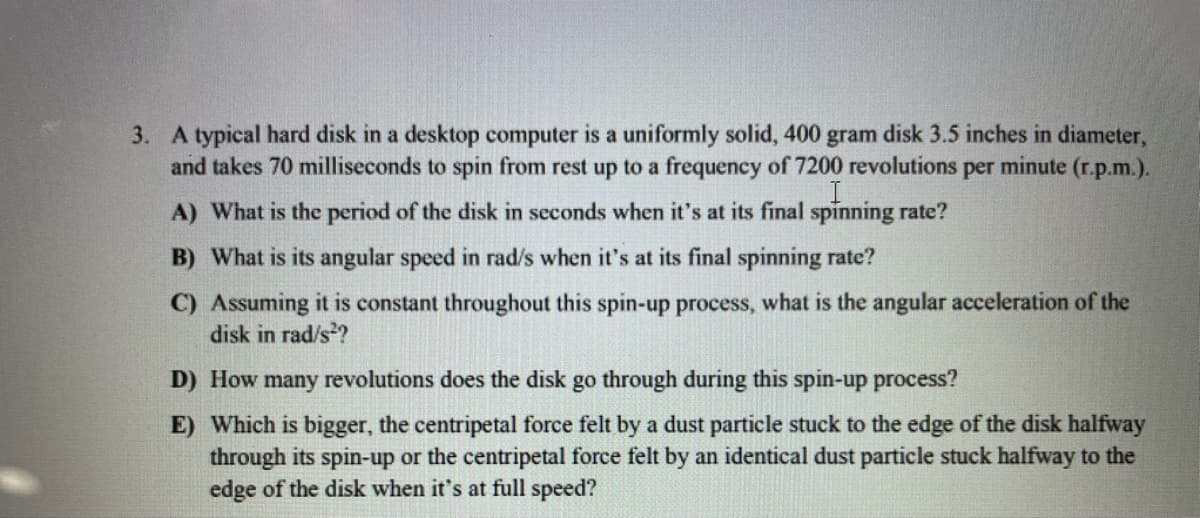3. A typical hard disk in a desktop computer is a uniformly solid, 400 gram disk 3.5 inches in diameter, and takes 70 milliseconds to spin from rest up to a frequency of 7200 revolutions per minute (r.p.m.). A) What is the period of the disk in seconds when it's at its final spinning rate? B) What is its angular speed in rad/s when it's at its final spinning rate? C) Assuming it is constant throughout this spin-up process, what is the angular acceleration of the disk in rad/s??
3. A typical hard disk in a desktop computer is a uniformly solid, 400 gram disk 3.5 inches in diameter, and takes 70 milliseconds to spin from rest up to a frequency of 7200 revolutions per minute (r.p.m.). A) What is the period of the disk in seconds when it's at its final spinning rate? B) What is its angular speed in rad/s when it's at its final spinning rate? C) Assuming it is constant throughout this spin-up process, what is the angular acceleration of the disk in rad/s??
College Physics
1st Edition
ISBN:9781938168000
Author:Paul Peter Urone, Roger Hinrichs
Publisher:Paul Peter Urone, Roger Hinrichs
Chapter6: Uniform Circular Motion And Gravitation
Section: Chapter Questions
Problem 16PE: Olympic ice skaters are able to spin at about 5 rev/s. (a) What is their angular velocity in radians...
Related questions
Question

Transcribed Image Text:3. A typical hard disk in a desktop computer is a uniformly solid, 400 gram disk 3.5 inches in diameter,
and takes 70 milliseconds to spin from rest up to a frequency of 7200 revolutions per minute (r.p.m.).
A) What is the period of the disk in seconds when it's at its final spinning rate?
B) What is its angular speed in rad/s when it's at its final spinning rate?
C) Assuming it is constant throughout this spin-up process, what is the angular acceleration of the
disk in rad/s??
D) How many revolutions does the disk go through during this spin-up process?
E) Which is bigger, the centripetal force felt by a dust particle stuck to the edge of the disk halfway
through its spin-up or the centripetal force felt by an identical dust particle stuck halfway to the
edge of the disk when it's at full speed?
Expert Solution
This question has been solved!
Explore an expertly crafted, step-by-step solution for a thorough understanding of key concepts.
Step by step
Solved in 3 steps with 2 images

Knowledge Booster
Learn more about
Need a deep-dive on the concept behind this application? Look no further. Learn more about this topic, physics and related others by exploring similar questions and additional content below.Recommended textbooks for you

College Physics
Physics
ISBN:
9781938168000
Author:
Paul Peter Urone, Roger Hinrichs
Publisher:
OpenStax College

Physics for Scientists and Engineers with Modern …
Physics
ISBN:
9781337553292
Author:
Raymond A. Serway, John W. Jewett
Publisher:
Cengage Learning

Physics for Scientists and Engineers
Physics
ISBN:
9781337553278
Author:
Raymond A. Serway, John W. Jewett
Publisher:
Cengage Learning

College Physics
Physics
ISBN:
9781938168000
Author:
Paul Peter Urone, Roger Hinrichs
Publisher:
OpenStax College

Physics for Scientists and Engineers with Modern …
Physics
ISBN:
9781337553292
Author:
Raymond A. Serway, John W. Jewett
Publisher:
Cengage Learning

Physics for Scientists and Engineers
Physics
ISBN:
9781337553278
Author:
Raymond A. Serway, John W. Jewett
Publisher:
Cengage Learning

College Physics
Physics
ISBN:
9781285737027
Author:
Raymond A. Serway, Chris Vuille
Publisher:
Cengage Learning

Physics for Scientists and Engineers, Technology …
Physics
ISBN:
9781305116399
Author:
Raymond A. Serway, John W. Jewett
Publisher:
Cengage Learning

Principles of Physics: A Calculus-Based Text
Physics
ISBN:
9781133104261
Author:
Raymond A. Serway, John W. Jewett
Publisher:
Cengage Learning